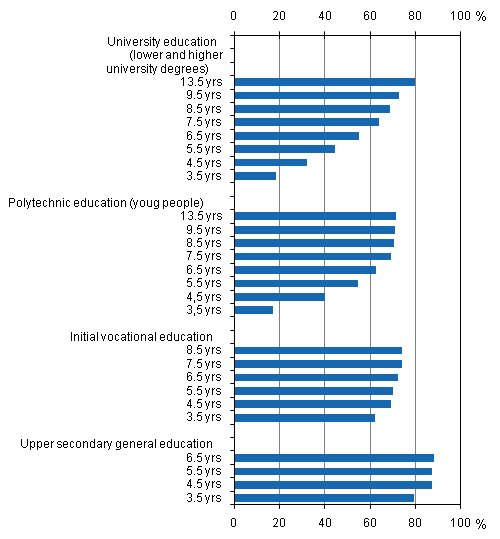Published: 20 May 2010
Completion of university degrees improved by over 10 percentage points
According to Statistics Finland, 44 per cent completed a university degree in five-and-a-half years, while the year before the figure was 12 percentage points lower. In the other sectors of education the pass rates were on level with the previous year. In four-and-a-half years polytechnic education aimed at young people was passed by 40 per cent of the new students. An initial vocational qualification was passed in three-and-a-half years by 62 per cent and a matriculation examination by 79 per cent.
Pass rate by educational sector in different reference periods by the end of 2008

The rise in the number of university degrees is explained by the university degree revision. According to the new degree system everybody as a rule attains a lower university degree before completing a higher university degree. Students also have the option to complete only a lower university degree. The figures also show those studying according to the old degree system who strived to complete their degree by the end of 2008, when the transition period to the new degree system ended. As many as 80 per cent of those having started studies in 1995 had graduated by 2008.
The pass rate of men was lower in all sectors of education than that of women, when viewing new students in university education in 2003, in polytechnic education in 2004 and in upper secondary general education and initial vocational education in 2005 at the end of 2008. Three-and-a-half years after starting upper secondary general education the pass rate of men was a few percentage points lower and in initial vocational education the pass rate of men was one percentage point lower compared with women. In tertiary level degrees the difference between men’s and women’s pass rates was considerably greater. Four-and-a-half years after starting studies 23 per cent of men had attained a polytechnic qualification, while the corresponding percentage for women was 54 per cent. A higher or lower university degree was attained in five-and-a-half years by 30 per cent of men and by 56 per cent of women. In the longer term the difference seems to level off. Among new university students in 1995, 72 per cent of men and 86 per cent of women had attained a degree after thirteen-and-a-half years of studies.
In all sectors of education there are big field-specific differences in the pass rates. Of the students who started their studies in 2003, relatively the highest numbers of higher university degrees were attained by the end of 2008 by students in the fields of social sciences, economics and administration and relatively the lowest numbers of degrees were attained by students of technology and transport. Among the students who started studies in 2004 in polytechnic education, the highest pass rate after four-and-a-half years was in the field of welfare, health and sports, where it stood at 64 per cent. The lowest pass rate, at 20 per cent, was in the field of technology and transport. In vocational education the highest pass rates after three-and-a-half years of starting studies were in the fields of humanities and education, and in welfare, health and sports, where a qualification had been attained by 66 per cent of the students. The pass rate was the lowest in the field of natural sciences, at 49 per cent.
Source: Education Statistics 2010, Statistics Finland
Inquiries: Annika Latva-Äijö (09) 1734 3273, koulutustilastot@stat.fi
Director in charge: Jari Tarkoma
Publication in pdf-format (204.0 kB)
- Tables
-
Tables in databases
Pick the data you need into tables, view the data as graphs, or download the data for your use.
Appendix tables
- 1. Progress of new upper secondary school students' studies by end 2008, youth education (20.5.2010)
- 2. Progress of new students' studies in initial vocational education by end 2008 (20.5.2010)
- 3. Progress of new polytechnic students' studies by end 2008, youth education (20.5.2010)
- 4. Progress of new university students' studies by end 2008, lower and higher university degrees (20.5.2010)
Updated 20.05.2010
Official Statistics of Finland (OSF):
Progress of studies [e-publication].
ISSN=1799-1021. 2008. Helsinki: Statistics Finland [referred: 19.4.2025].
Access method: http://stat.fi/til/opku/2008/opku_2008_2010-05-20_tie_001_en.html

